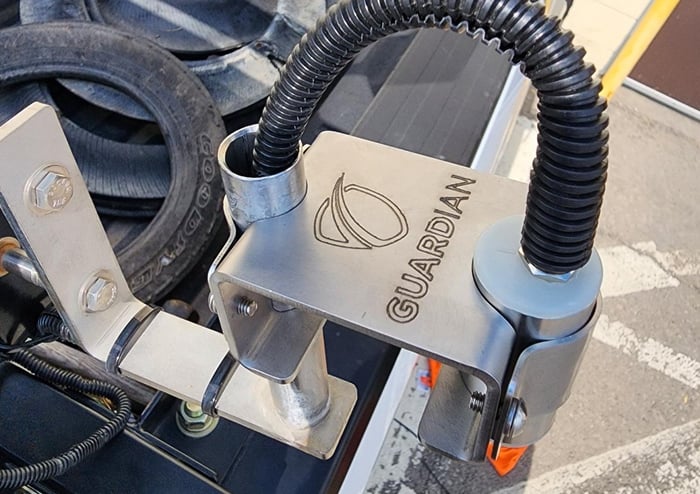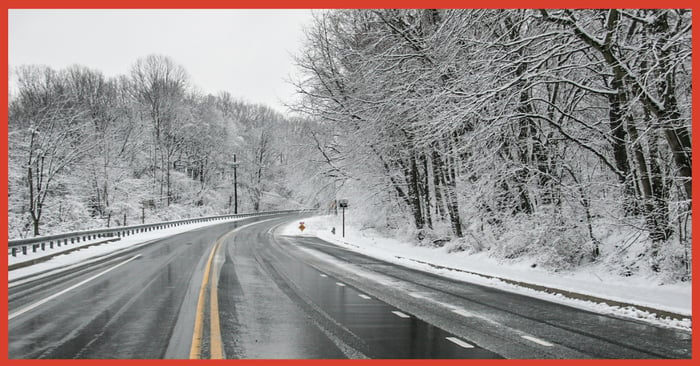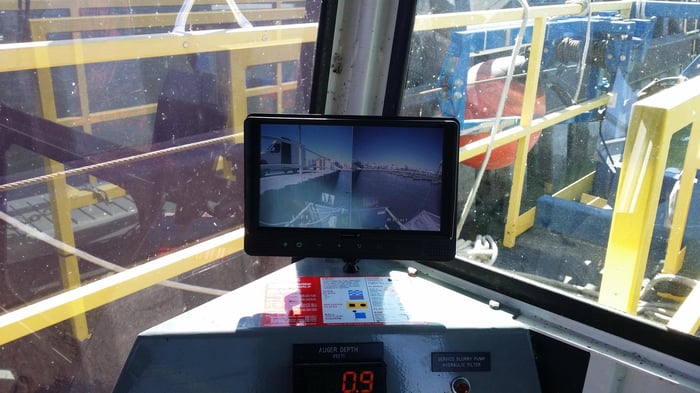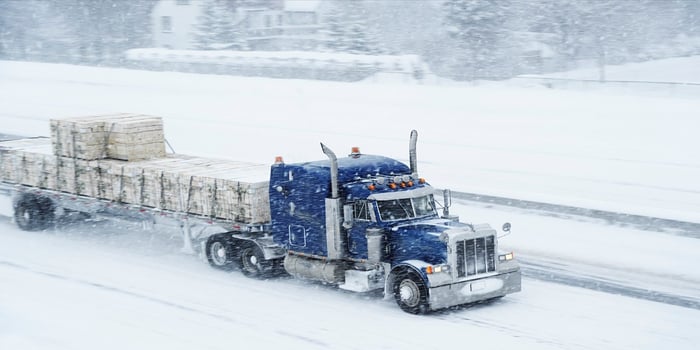
Table of Contents
DiCAN is thrilled to announce its latest innovation, the Guardian Temperature Sensor. In a world where road safety and efficiency are paramount, Guardian sets a new standard in air and road temperature monitoring.Today, we’re taking you on a journey through the Guardian Temperature Sensor, exploring its inner workings, the myriad benefits it brings, and why mobile sensors have become an indispensable tool for managing your vehicle fleets.
With this technology, you can gain a competitive advantage, enhance safety, and optimize efficiency, no matter what Mother Nature throws your way. So, let’s dive in and uncover how the Guardian Temperature Sensor is poised for your fleet management.
How Temperature Affects Road Conditions
Temperature extremes present significant challenges to road infrastructure, directly impacting both public and private fleet operations. During winter, freezing temperatures lead to icy conditions and snow accumulation on roads, heightening accident risks for fleet vehicles. The recurrent freeze-thaw cycles also contribute to roadway deterioration, manifesting in potholes and frost heaves that can damage fleet vehicles and disrupt schedules.
Road Temperature Vs Air Temperature– Understanding the Difference
It’s vital to grasp the nuances between surface and air temperatures, as they can significantly influence fleet operations.
Surface temperature, or pavement temperature, is a key factor for decision-making. When pavement temperatures remain above freezing, roads are likely to stay clear during snow or ice events. However, when they drop below freezing, the efficacy of de-icing chemicals changes, requiring a different approach to maintain road safety.
Air temperature, measured about 4 feet above ground, indicates the broader climatic conditions. These two temperatures can vary considerably, impacting your fleet’s operations.
For example, under clear, calm night skies, the ground can cool rapidly, dropping 2 to 5 degrees cooler than the air just above. This can result in frost on roads even when air temperatures are above freezing.
These variations highlight why relying solely on air temperature readings for vehicles can be misleading. Understanding these differences allows you to better anticipate and adapt to varying road conditions, ensuring both safety and efficiency in your fleet management.
Dew Point and Air Temperature
In addition to air and road temperatures, dew point is another critical variable to consider when assessing road safety for your vehicle fleets.
The dew point is essentially the temperature at which the air must be cooled for it to become saturated, leading to the condensation of moisture. Reported in either Fahrenheit or Celsius, the dew point can be equal to or lower than the air temperature, but never higher.
The relationship between air temperature and dew point temperature is of particular importance. When there’s a substantial difference between these two values, it indicates that a significant amount of additional moisture is required to saturate the air. Conversely, when the air temperature and dew point are close, it suggests that the air is nearly saturated.
This dynamic becomes especially important when anticipating the onset of snowfall, as the difference between the two can affect how quickly the snow reaches the ground.
When there’s a larger difference between air temperature and dew point, it often results in a delay in the commencement of snowfall, as the air requires more moisture. However, when there’s a smaller difference between these two values, it indicates that the air is already close to saturation, indicating a more immediate onset of snowfall, as the air is primed to release moisture in the form of snowflakes.
Understanding this dynamic is essential in effectively preparing for winter weather conditions and making informed decisions regarding road safety. It allows for more precise predictions about snowfall timing and can assist in mitigating the risks associated with adverse weather, ultimately ensuring safer road conditions for your drivers.
Dew Point and Weather-Related Transportation
Dew point also has a substantial impact on weather-related transportation issues. However, it often goes undetected by drivers.
Unlike heavy rain, ice, or snow, the effects of atmospheric moisture on road surfaces are often invisible to drivers. This hidden danger can make road conditions even more treacherous since it doesn’t trigger changes in driving behaviour, making it difficult for drivers to adapt to these challenging circumstances.
Monitoring the dew point is critical for the safety of your vehicle fleets. The temperature of pavement can quickly fall below the dew point of the air, resulting in the formation of condensation on the road surface. If this occurs and the pavement temperature is below freezing, frost can begin to develop on the road, posing a threat to your drivers similar to that of snow or ice.
An even more concerning scenario arises when the road surface falls below the dew point but has not yet reached freezing temperatures. In such cases, dew or liquid water begins to form on the pavement surface. If the pavement temperature subsequently drops below freezing, this liquid water can freeze, giving rise to black ice. Black ice is particularly hazardous as it transitions from a liquid to a solid state, making it virtually invisible to drivers. The lack of visibility makes it extremely challenging for drivers to anticipate and react to this treacherous road condition.
Monitoring and understanding the dew point is essential for making informed decisions about road safety, particularly for your vehicle fleets. This knowledge allows for better preparedness and more effective risk mitigation during various weather conditions, ultimately ensuring the safety of your drivers and the successful transportation of your vehicles.
Forecasting Dangerous Road Weather Conditions

Fig 1: A multi-panel chart illustrating the correlation between air and road temperatures, dew point, and humidity to highlight black ice formation risk over a sample 24-hour period.
Anticipating weather conditions is crucial for ensuring the safety of our road systems.
A new development in this area is the integration of advanced sensors capable of simultaneously measuring road temperature, air temperature, dew point, and humidity– the four critical factors in forecasting dangerous road conditions. The chart above visually represents how these factors cooperate to increase the risk of ice formation, a key concern in road safety. When air and road temperatures (depicted in red and blue) drop below freezing, and this overlaps with high humidity (purple line) and a low dew point (green line), the risk for black ice formation increases, as indicated by the shaded areas. This visualization aids in understanding the complex interplay of these factors, enhancing road safety measures.
Government agencies across North America have long relied on Road Weather Models (RWM) to monitor these conditions. Typically managed through designated locations equipped with Fixed Road Weather Information Systems (RWIS), these systems measure pavement temperature and dew point at specific locations, offering your vehicle fleets essential information for making informed decisions during adverse weather events.
Over time, RWIS systems have evolved to become quite advanced, with some stations capable of detecting de-icing chemicals on the road, measuring the freeze point of liquids by physically freezing them, and even monitoring road conditions using roadside sensors. The utilization of RWIS by road maintenance personnel has demonstrated its ability to enhance service levels, leading to better road conditions and ultimately saving lives.
Nevertheless, a significant challenge with these systems remains as they’re only able to provide data pertaining to their fixed location. RWIS continues to struggle with authorizing enough sites to establish a comprehensive weather network necessary for accurate decision-making. RWS, though valuable, do not cover the entire road network and are often sparsely scattered, which may result in missing local weather phenomena. The variability of road temperatures and air temperatures over short distances underscores the need for a more comprehensive and adaptable approach to weather monitoring and forecasting on our road systems.
Despite these limitations, RWMs should still be integrated into intelligent transport systems. Their furthered integration not only enhances safety but also contributes to growing concerns about emissions and traffic congestion.
The goal here is not to replace RWIS but to strengthen the existing weather network of road weather information, ensuring a more robust system for anticipating weather conditions and, in turn, safeguarding the safety of all road users.
Mobile Temperature Sensors– From the 1990s to Today
Mobile Temperature Sensors have revolutionized how fleets track temperatures on the road.
This innovation can be traced back to the 1990s, when the concept of collecting weather data using vehicles first emerged, leading to the development of vehicle-mounted infrared pavement temperature systems.
Over the years, these systems have gained immense popularity due to their ability to enhance the coverage and quality of observation on roads. This, in turn, has greatly improved the efficiency of winter maintenance operations and the provision of traveller warnings.
Despite their increasing sophistication, these sensors remain focused on monitoring what matters most- a growing list of atmospheric and on-road conditions. This includes tracking parameters such as air temperature, relative humidity, dew point, road pavement temperature, road surface condition status, and pavement grip. These data points offer invaluable insight into the environment in which the vehicle is operating.
Strategically installed, these sensors empower fleet operators with real-time road temperature information within their area of responsibility. Furthermore, they provide snow plow operators with a crucial decision-making tool, enabling them to make informed choices regarding treatment applications. Mobile temperature sensors have become an indispensable tool for modern fleet management, bolstering safety and operational efficiency on the road.
Mitigating Risks with Guardian Mobile Temperature Sensor
Mobile temperature sensors have become a vital tool for modern fleets, playing a pivotal role in ensuring operational safety and efficiency. However, it’s important to recognize that not all temperature sensors are created equal.
Introducing, Guardian.
Guardian is purpose-built to offer you the ultimate protection and precision. Its capabilities extend far beyond the basics, accurately measuring road temperatures, air and dew point as well as humidity, making it a versatile solution for a wide array of applications.
With Guardian, you have the advantage of real-time feedback on road surface conditions and the convenience of seamlessly switching between Fahrenheit and Celsius with a simple click.
Guardian’s externally mounted design ensures a hassle-free installation, compatible with standard Geotab and similar interface equipment without the need for additional configuration. Its rugged 316SS construction allows it to thrive in even the most aggressive environments, delivering reliable and superior performance in all conditions.
But Guardian’s usefulness extends beyond just winter operations. It proves invaluable in tasks such as applying roadway paint markings and vegetation control, where real-time knowledge of humidity levels in the air is essential. In the past, obtaining this data often required relying on fixed RWIS or distant airport observations, which could be outdated and far from the actual site.
With Guardian, you have a reliable and up-to-date solution at your fingertips. You can trust Guardian to keep you well-informed, no matter what challenges or weather you encounter.
Benefits of Guardian
Reduction of Salt and Chemical Material Usage. Guardian plays an essential role in minimizing the unnecessary usage of salt and chemical materials for road maintenance. This optimization is not only cost-effective but also environmentally friendly, as it helps prevent excessive runoff of these substances into the environment.
Detailed and Accurate Road Condition Information. Guardian effectively bridges the gap between fixed weather systems. It provides a more comprehensive and accurate understanding of road conditions, allowing for a clearer picture of how roads are affected by weather and how remediation efforts are performing. This information is invaluable for making data-driven decisions and optimizing road maintenance operations.
Improved Road Weather Models. When a vehicle fleet is equipped with a Guardian Temperature Sensor, it contributes to the improvement of road weather models. These sensors provide real-time data that significantly enhances the accuracy of road weather forecasting. This, in turn, enables the issuance of timely warnings to nearby vehicles and informs road management authorities about dangerous road conditions. Such early warnings empower authorities to take prompt preventative actions, including salting roads or snow removal, which enhances safety and reduces the potential for accidents.
Feel Protected On The Road With The Guardian Temperature Sensor
In today’s fast-paced work, where fleet safety is paramount, you can rely on the Guardian Temperature Sensor to be your trusted partner.
With advanced technology, measuring road temperatures, air, dew point and humidity, has never been easier. Our commitment to delivering accurate data and real-time information empowers you to make informed decisions, especially when you’re up against challenging weather conditions.
Your safety is our top priority. We invite you to contact us today for your fleet and road safety.





